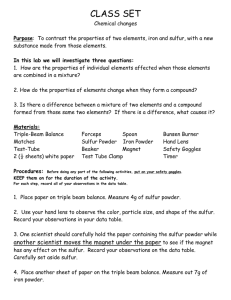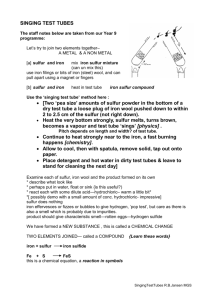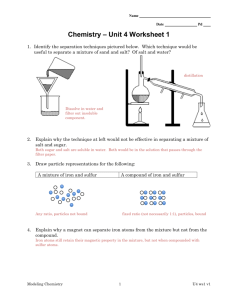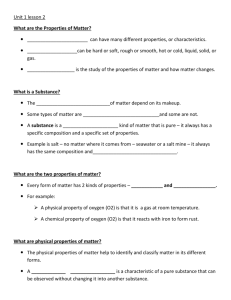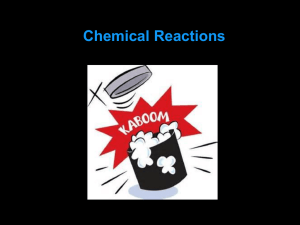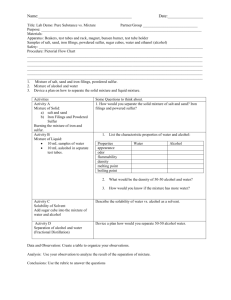Sulfur and Iron Lab: Mixtures vs. Compounds
advertisement
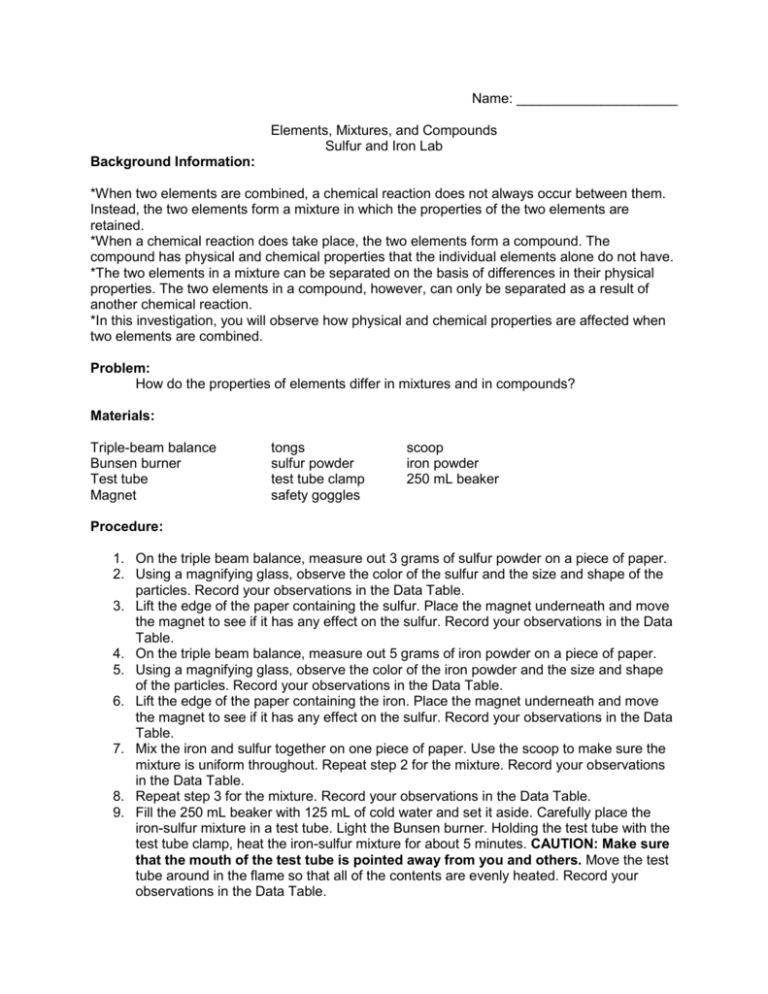
Name: _____________________ Elements, Mixtures, and Compounds Sulfur and Iron Lab Background Information: *When two elements are combined, a chemical reaction does not always occur between them. Instead, the two elements form a mixture in which the properties of the two elements are retained. *When a chemical reaction does take place, the two elements form a compound. The compound has physical and chemical properties that the individual elements alone do not have. *The two elements in a mixture can be separated on the basis of differences in their physical properties. The two elements in a compound, however, can only be separated as a result of another chemical reaction. *In this investigation, you will observe how physical and chemical properties are affected when two elements are combined. Problem: How do the properties of elements differ in mixtures and in compounds? Materials: Triple-beam balance Bunsen burner Test tube Magnet tongs sulfur powder test tube clamp safety goggles scoop iron powder 250 mL beaker Procedure: 1. On the triple beam balance, measure out 3 grams of sulfur powder on a piece of paper. 2. Using a magnifying glass, observe the color of the sulfur and the size and shape of the particles. Record your observations in the Data Table. 3. Lift the edge of the paper containing the sulfur. Place the magnet underneath and move the magnet to see if it has any effect on the sulfur. Record your observations in the Data Table. 4. On the triple beam balance, measure out 5 grams of iron powder on a piece of paper. 5. Using a magnifying glass, observe the color of the iron powder and the size and shape of the particles. Record your observations in the Data Table. 6. Lift the edge of the paper containing the iron. Place the magnet underneath and move the magnet to see if it has any effect on the sulfur. Record your observations in the Data Table. 7. Mix the iron and sulfur together on one piece of paper. Use the scoop to make sure the mixture is uniform throughout. Repeat step 2 for the mixture. Record your observations in the Data Table. 8. Repeat step 3 for the mixture. Record your observations in the Data Table. 9. Fill the 250 mL beaker with 125 mL of cold water and set it aside. Carefully place the iron-sulfur mixture in a test tube. Light the Bunsen burner. Holding the test tube with the test tube clamp, heat the iron-sulfur mixture for about 5 minutes. CAUTION: Make sure that the mouth of the test tube is pointed away from you and others. Move the test tube around in the flame so that all of the contents are evenly heated. Record your observations in the Data Table. 10. When you see no further changes occurring in the test tube, shut off the Bunsen burner and immediately put the test tube into the beaker of cold water. If the test tube does not break, wrap it in several layers of paper towel and hit it with a hammer to crack the glass. 11. Using the tongs, magnifying glass, and magnet---examine the substance formed in the test tube. Record your observations in the Data Table. Observations: Data Table Physical Properties Color Sulfur Iron Iron-Sulfur Before Heating Iron-Sulfur After Heating Shape of particle Size of particle Effect of magnet What did you observe when you began heating the test tube containing the mixture of sulfur and iron? Analysis and Conclusions: 1. How did the properties of sulfur alone compare with the sulfur in the unheated iron-sulfur combination? 2. How did the properties of the iron alone compare with the iron in the unheated iron-sulfur combination? 3. How did the properties of sulfur alone compare with the iron-sulfur combination after it was heated? 4. How did the properties of iron alone compare with the iron-sulfur combination after it was heated? 5. What kind of substance was the iron-sulfur combination before heating? 6. What was the effect of heating the iron-sulfur combination? 7. What kind of substance was the iron-sulfur combination after heating? Critical Thinking and Application: 8. Explain how you know that mixing the iron and sulfur together on the paper results in a mixture of the two substances. 9. Explain how you know that heating the iron and sulfur together in the test tube results in a new compound composed of chemically combined iron and sulfur. 10. Why was it necessary to heat the test tube in order for a chemical reaction to occur? 11. The element sodium reacts explosively with water and the element chlorine is a yellowing-green poisonous gas. When chemically combined, sodium and chlorine form non-explosive, nonpoisonous table salt. Explain how this can be. 12. Identify each of the following as an element, a mixture, or a compound. a. aluminum foil: b. air: c. water: d. salt water: e. copper wire: f. steel:
